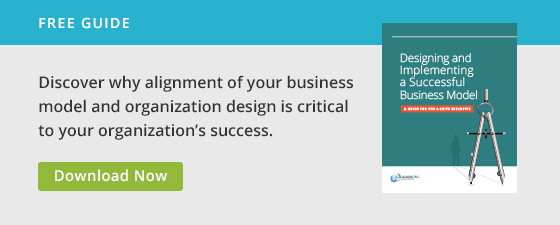When a company hires an organization design consultant to work with them, most of the time they’re looking for an answer. Getting an answer to “what is the optimal way to do things or set things up” is indeed an important result of the organization design process. However, it is just one aspect of what a good organization design consultant can and should do for a company.
Leaders should be aware of two additional important dimensions to a good organization design process. Whether or not they know it, when a company hires a consultant to help them with their organization design, they’re ideally hiring for all three purposes. Knowledge of these three factors can help leaders choose an organization design consultant who will guide the organization to success.
Don’t Stop at the Solution
A good organization design process will lead to these three things:
- An answer. Getting a solution to your organization design problem is important because it gives you the clarity you need to take your organization in a good direction for your business. It provides a blueprint or roadmap to show you where you want to be and how to get there.
- Alignment around what the right answer is. Leadership alignment is important because it allows you to move towards your goal with purpose and with speed. Even if the person in charge is very clear about where to go, the proverbial “the canoe won’t get very far very fast if everyone is paddling in different directions” applies here. If not everyone in the organization understands and/or buys in to the answer you’ve come up with, you still have a significant limitation to achieving success. Alignment among leaders ensures that everyone is working together with a common purpose to enable the optimal organization design solution.
- An understanding of how things need to work to implement the answer. The final component is knowing how things need to work. Human beings rely a lot on “muscle memory,” or existing patterns of behavior. Whenever something changes in our routines, we tend to revert back to the tried and true, to what we’re already good at and used to that brought us past success. The same is true when we enact changes in an organization: if people don’t understand how a new process or role or metric is supposed to work, they tend to revert back to old ways of doing things—and nothing actually changes. If, however, they really understand the mechanics of how the new organization design works, it is much easier for them to override those old patterns and create new patterns of behavior that will drive change.
We use the organizational Rubik’s cube model as a foundation to develop an organization design process that delivers all three of these results for our clients. As leaders align their business across all sides of the organizational cube, they do get what most leaders want – an answer or solution. But, they also get the additional results they need to enable proper implementation of those solutions: leadership alignment and deep understanding around how to implement and execute the optimal design.
The Right Organization Design Process Leads to Effective Results
As you examine your own organization design process, ask yourself:
- Do you have a process that will deliver a good blueprint for moving forward?
- Does your process create alignment of thought in the way people think about how they’re going to move forward?
- Does your process provide people clarity on how things are going to change, so they can make good decisions and actually implement the design?
An answer is important, but an answer alone won’t necessarily produce results. Having all three of these elements is a good indication that the process you are using or considering is indeed going to get you the results you want for your organization.






